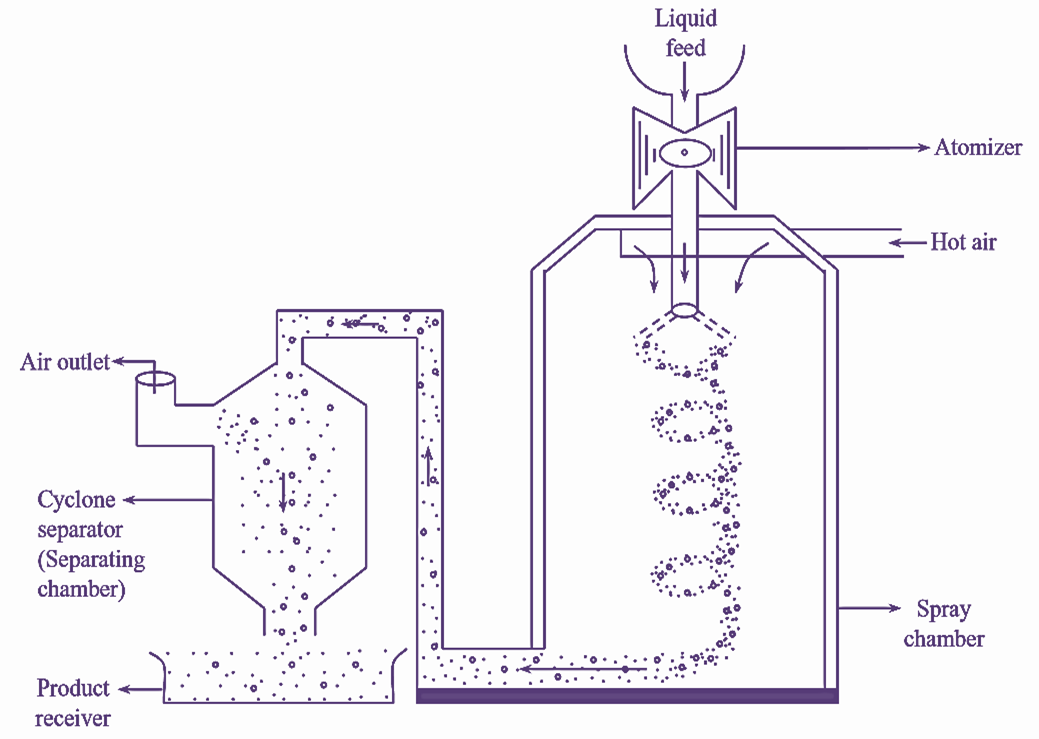
Figure 1: Spray Dryer.
Working Principle of Spray Dryer
The feed solution consisting of dispersed core in coating solution is sprayed through an atomizer (produces fine droplets) from the top of the spray chamber. As the liquid feed moves downward, it interacts with circulating hot air. Thus solvent present in droplets gets evaporated, as a result of which dry microcapsules are formed. Drying is achieved in a very short time i.e., even before the droplets, reach the bottom of the drying chamber (usually 2-3 seconds). Spraying the droplets of sufficient smaller size and subsequent interaction with hot air is the important step in whole process.
Construction of Spray Dryer
Spray dryer consists of a spray chamber and a separating chamber (cyclone separator). They are interconnected by means of a narrow pipe (see Figure 1). An atomizer is fitted at the top of the spray chamber which sprays the feed as droplets. An inlet for hot air (or gas) is present at the top. The entire equipment is made up of stainless steel. The cyclone separator is provided with two outlets one at the top and another at the bottom, below which a product receiver is placed. The internal lining of the spray chamber is smooth. The diameter and height of the spray chamber vary depending upon the type of operation.
Working of Spray Dryer
Feed solution consisting of dispersed core is passed into the atomizer from where it is sprayed as small droplets. The nozzle delivers these droplets radially into the spray chamber. The size of the droplets must be as small as possible in order to facilitate rapid drying. When hot air is introduced into the spray chamber, the liquid interacts with the hot air and get dried. As a result, solid particles are formed which then follow helical path and reach the bottom of the spray chamber.
The temperature of the hot air must be sufficiently high (usually in between 300 to 15000 °F), so as to make the drying process effective. Coarse and fine solid particles obtained travel along with air into the cyclone separator, where the air is removed and particles are collected in the product receiver.
Advantages of Spray Dryer
- It takes few seconds (3-30 seconds) to achieve complete drying.
- The rate of heat transfer is high.
- Solutions, suspensions and thin pastes can be dried in a single step.
- Large quantities of materials can be dried.
- It is the most useful method when products containing sphere shaped particles of uniform and controlled size are required.
- Low labour cost.
- Sterile substances can also be dried.
Disadvantages of Spray Dryer
- Equipment is bulky and expensive.
- Well trained labour is required.
- Low thermal efficiency due to loss of heat in the form of discharged gases.
- Complete recovery of product is not possible.
Applications of Spray Dryer
| Type of product | Examples |
| Inorganic substances | Barium sulphate, boric acid, calcium sulphate, citric acid, ferrous sulphate, sodium phosphate, sulphur etc. |
| Drugs | Bacitracin, chioramphenicol succinate, dextran, penicillin, etc. |
| Biologicals | Blood, hormones, serum, plasma, etc. |
| Miscellaneous | Acacia, adrenaline, coffee extract, detergents, fruit juices, gelatine, lactose, methyl cellulose, milk, pepsin, soaps, vaccines, yeast etc. |